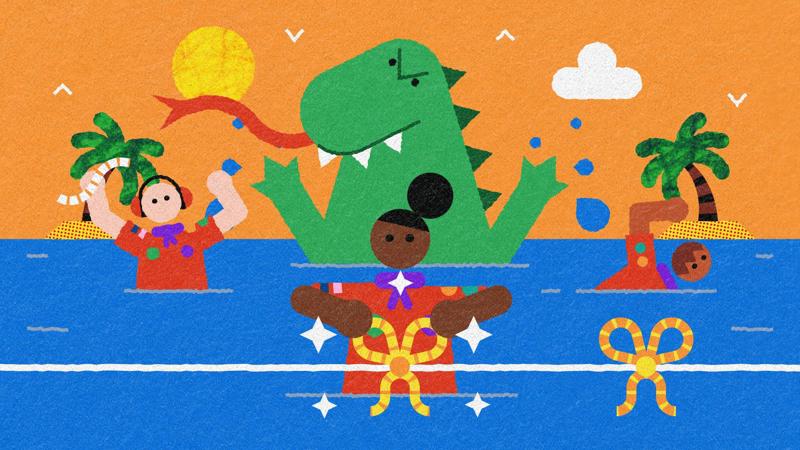
Play Dragon Dash
You’ll need
- Rope
- Whistles
- Lengths of wool or ribbon around 40cm each
Before you begin
- Use the safety checklist to help you plan and risk assess your activity. Additional help to carry out your risk assessment, including examples can be found here. Don’t forget to make sure all young people and adults involved in the activity know how to take part safely.
- Make sure you’ll have enough adult helpers. You may need some parents and carers to help if you’re short on helpers.
Planning the game
- Find an area with plenty of safe hiding spaces, without people leaving the agreed boundaries.
- Set boundaries with your group for during the game, which you could mark out with cones or natural features, such as walls and hedges.
- Remember to check the terrain and make sure the game area is free of hazards. For example, hazards could be roads, dips in the grass, steps, rocks or rivers if you’re playing outside. If you’re playing inside, the hazards could be chairs, tables or people’s belongings.
Setting up the game
- To create a ‘beach’, safely and securely tie a rope between two trees or objects, such as tables. The beach will be protected by the fierce dragons. Remember to warn everyone about the rope, so they don’t run into it.
- To create a ‘boat’, set up a hoop that’s a suitable running distance away from the rope. You could also have several bases or ‘boats’ dotted around the area.
- To create ‘flares’, put lengths of coloured wool or ribbons in each ‘boat’.
- To create the dragon's den, set up a coned space somewhere in the playing area. Any survivor caught by the dragons will have to go and stand in the dragon’s den. A survivor can be released from the den if another survivor tags them and sets them free.
Explain the game
- Gather everyone in a circle and remember to warn everyone about the rope, so they don’t run into it.
- Did you know Komodo dragons are huge, dangerous lizards that live on three islands in Indonesia and work as a team to capture their prey? People will need to work as a team in this game.
- Explain that group of survivors are trapped on a desert island with some fierce dragons. The need to collect some ‘flares’ to signal for help.
- When the game begins, survivors run forward to pick up the ‘flares’ from the ‘boats’.
- Survivors must run over to a ‘beach’ (rope) then try and tie the ‘flares’ onto the rope to release them. ‘Flares’ must be tied to the rope with a knot, not just draped over the rope. You can also use pegs if people may struggle to tie a knot.
- If a dragon catches a survivor by touching them, the survivor must give the dragon any ‘flares’ they're holding. The dragon should take the survivor to the dragon’s den.
- The dragon then returns the ‘flare’ to the ‘boats’, so they can be collected by someone else.
- A survivor can be released from the den if another survivor tags them and sets them free.
Play the game
- Choose three or four people to be the dragons. Their job is to guard the ‘beach’. Find a way to identify the dragons - they could be the players wearing neckers or they could wear a hat.
- The rest of the group will be the survivors.
- The survivors could work as a team to distract the dragons, while someone takes their ‘flare’ from the ‘boat’ to the ‘beach’. People can also run in pairs.
- The dragons can also work as a team or in pairs. They could corner survivors, or one dragon could protect the ‘beach’ while other dragons chase survivors.
- Players will work out very quickly that it’s better to work together to dodge, protect, distract and attack.
- A game will last about 10 to 15 minutes. Everyone plays until either time is up, all the ‘flares’ are at the ‘beach’, or until all survivors have been caught by the dragons.
- To make the game easier, you could move the ‘boats’ nearer the ‘beach’.
- Pegs are a good way to fix the ‘flares’ if people find knots tricky.
- Try to swap dragons and runners at regular intervals too after each game.
Reflection
This activity gets everyone in the group moving over a wide area, and also builds their teamwork skills.
When everyone is sat having a drink and rest afterwards, they should think about the game they just played. Chat about the brilliant techniques people used, such as zigzagging to avoid the dragons and distracting runners tying their ‘flares’.
Everyone should think about how the game wasn’t just about being fast, but about patience and good team work. Everyone had to wait, watch and help teammates. Teamwork is always a good idea when tackling a problem or activity.
Safety
All activities must be safely managed. You must complete a thorough risk assessment and take appropriate steps to reduce risk. Use the safety checklist to help you plan and risk assess your activity. Always get approval for the activity, and have suitable supervision and an InTouch process.
- Outdoor activities
You must have permission to use the location. Always check the weather forecast, and inform parents and carers of any change in venue.
- Active games
The game area should be free of hazards. Explain the rules of the game clearly and have a clear way to communicate that the game must stop when needed. Take a look at our guidance on running active games safely.
- Contact games and activities
Make sure everyone understands what contact is acceptable, and monitor contact throughout the activity.
Spread the teams over a wider area, or perhaps a wooded area where runners can use trees as camouflage. Or set up two ropes and more islands.
If anyone has problems with mobility, move the island base nearer the rope or partner them up with someone who can be the runner while they give instructions. Pegs are a good way to fix the ‘flares’ if people find knots tricky.
All Scout activities should be inclusive and accessible.
Challenge another section to compete or hold heats to find the ultimate champions.



